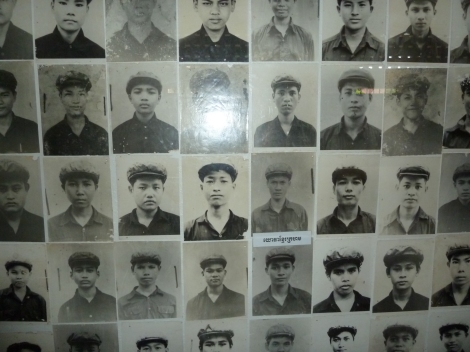How many of you know about the mass murders that took place in Cambodia in the late 1970’s? In four short years, more than 25% of the population was killed, either through direct murder or starvation and overwork, due to the Khmer Rouge led by Pol Pot. The following post is about what I felt after going to the Choeung Ek Killing Field near Phnom Penh and the Genocide Museum S-21 Prison, where people, including women and children and babies were tortured and killed. They targeted educated people (lawyers, teachers, doctors, anyone who wore glasses) and then people in their own ranks. If you want to learn more about it, please go to this site http://worldwithoutgenocide.org/genocides-and-conflicts/cambodian-genocide. It explains what happened better than I could.
At the killing fields and genocide museum, the saddest things that I saw were not the hundreds of skulls and bones of the people murdered, or the painting of babies being thrown up against a tree to kill them so that they would not take revenge on what happened to their parents. Those were just paintings, and human skulls are something that, even though you know where they came from, it’s something less personal, something medical and scientific. The saddest thing that I saw were the murdered people’s clothes in a heap. Clothes that a young mother lovingly picked out her first child. A dress that a lady chose because she thought that she looked really pretty in it and that might get her husband to give her a compliment. A shirt that a lawyer wore that gave him confidence. A uniform that a soldier proudly wore because he thought that he was bringing freedom to his country. We put on clothes every day, and for whatever reason we put them on, it is never because we think that it might be the last pair of clothes that we will ever wear. The clothes in a heap were the saddest things I saw that day.
Why do you think that we are not taught about this in school, even though it happened so recently, yet we hear so much about Hitler and the Holocaust?

The Peace Pagoda in the Killing Fields near Phnom Penh. It is filled with the skulls of some of the victims whose bodies were found in the mass graves nearby.

As you can see, the skulls have holes in them. This is because they said that bullets were too expensive, it was cheaper to kill the people by smashing their skulls in than shooting them.

This is a box filled with some left over bones. After the mass graves were excavated, when it rains a lot, some of the bones that were deep in the ground come up to the surface.

Some of the clothes of the victims. The saddest piece that I saw was a pair of little shorts for a little boy maybe aged 3 or 4 years old.

These are rules for those who entered the S-21 prison, now the genocide museum. They were interrogated and tortured here first, and then eventually sent to the killing fields, but only if they survived the torture.















This is very interesting and sad. Yes, I had heard of this.
________________________________
So Sad. I have never heard of this before. Thanks for sharing your experience.